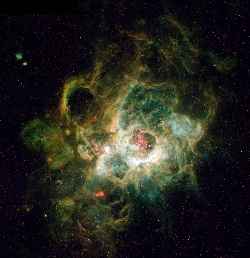 |
|
||
|
The Interstellar Medium—What is it? Most of us, at one time or another, have learned that space is a perfectly empty vacuum. But the vast space between the stars is really not empty, it is sparsely sprinkled with gas and dust. This ‘stuff’ in the vast spaces between the stars is known as the Interstellar Medium (or ISM). About 99% of the ISM is gas (hydrogen and helium), the remaining one percent consist of heavier elements and dust. The gas is extremely dilute, with an average density of about 1 atom per cubic centimeter. The air we breathe is approximately 30 quintillion (30,000,000,000,000,000,000,) times more dense than the ISM. Picture this: an "empty" coffee mug in the ISM would contain about 500 hydrogen molecules. The same "empty" coffee mug sitting on your desk contains about 1500 quintillion gas molecules - mostly nitrogen, hydrogen and oxygen. The dust in the ISM is made of tiny, irregularly shaped particles of silicates, carbon, ice and iron. In areas where the dust is thick, the light from nearby stars can be completely blocked - similar to the way dark clouds block light from the sun.
|
||
 Light from nearby stars
can also be reflected from the interstellar dust, similar to the
way light from a car's headlights can reflect off fog. The
picture (right) shows a reflection
nebula - a cloud of interstellar gas and dust illuminated by and reflected light
from the star it surrounds. The picture was taken by
the Hubble Space Telescope, and is of NGC 1999, a nebula in the
constellation Orion. Light from nearby stars
can also be reflected from the interstellar dust, similar to the
way light from a car's headlights can reflect off fog. The
picture (right) shows a reflection
nebula - a cloud of interstellar gas and dust illuminated by and reflected light
from the star it surrounds. The picture was taken by
the Hubble Space Telescope, and is of NGC 1999, a nebula in the
constellation Orion.
Unlike the dust in the interstellar medium, which can only reflect or block light, the gas in the interstellar medium glows in visible and many other wavelengths. In the region of hot, newly-formed stars, clouds of hydrogen gas are ionized by the ultraviolet radiation emitted from the stars. When free electrons recombine with the ionized hydrogen, visible red light is emitted from the hydrogen gas. This accounts for the red colors in photographs of emission nebulae, such as the Trifid and Orion Nebulae.
(If you are interested in learning more about the ISM - check out this collection of links to various sites with more information.) |
||
The Local Bubble: our astronomical neighborhood
Our solar system is located in a an unusual region of space called the Local Bubble. The Local Bubble is about 300 light years in radius and is filled with extremely low density gas (about 0.001 gas molecules per cubic centimeter) - this is much less dense than the average ISM surrounding it. The coffee mug that would contain about 500 hydrogen molecules in the ISM would only contain 1 hydrogen molecule (or maybe none at all!) if it were in the Local Bubble. This gas is also extremely hot - about one million Kelvin, or almost 200 times as hot as the surface of the sun! Astronomers believe that this bubble may have been created by a supernova explosion - that is, the explosion "blew" most of the gas and dust from the interstellar medium outward. It is this extremely diffuse gas, inside the Local Bubble, that the CHIPS mission is studying.
Inside this Local Bubble is a cloud of denser gas about 60 light years across. Currently, our sun and solar system, along with a few other nearby stars, and variety of small colder clouds are passing through this cloud - we are located about 4 light years from its edge.




 The hydrogen gas in
the ISM can also form relatively cool clouds that emit light in the radio band of the
The hydrogen gas in
the ISM can also form relatively cool clouds that emit light in the radio band of the